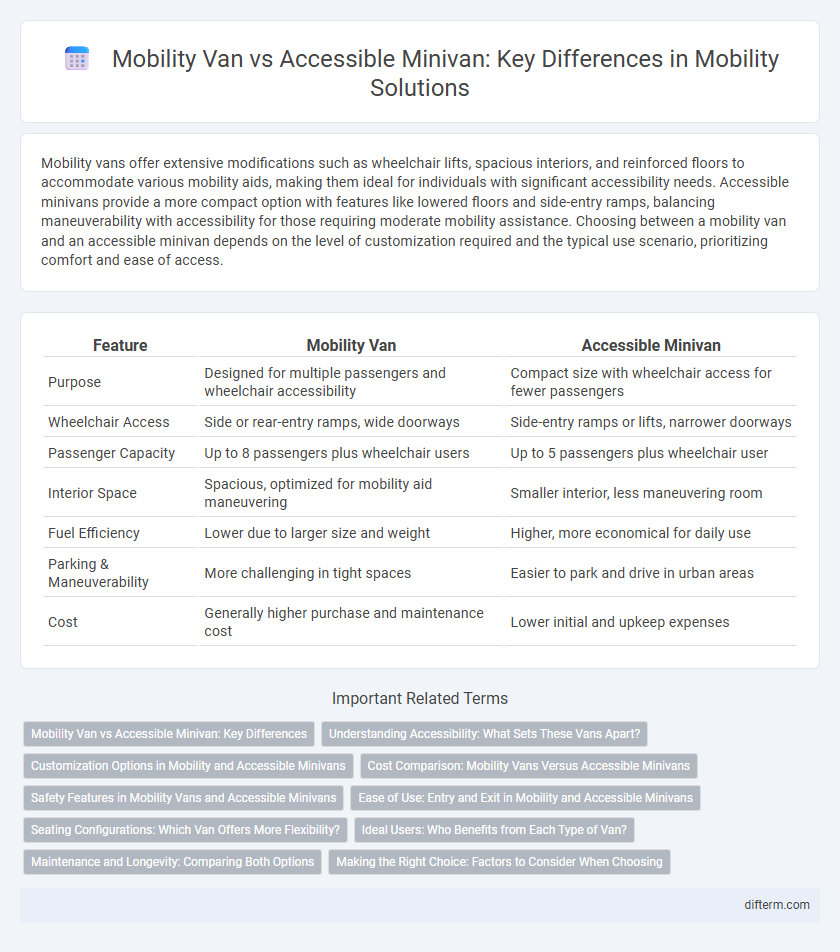Mobility vans offer extensive modifications such as wheelchair lifts, spacious interiors, and reinforced floors to accommodate various mobility aids, making them ideal for individuals with significant accessibility needs. Accessible minivans provide a more compact option with features like lowered floors and side-entry ramps, balancing maneuverability with accessibility for those requiring moderate mobility assistance. Choosing between a mobility van and an accessible minivan depends on the level of customization required and the typical use scenario, prioritizing comfort and ease of access.
Table of Comparison
| Feature | Mobility Van | Accessible Minivan |
|---|---|---|
| Purpose | Designed for multiple passengers and wheelchair accessibility | Compact size with wheelchair access for fewer passengers |
| Wheelchair Access | Side or rear-entry ramps, wide doorways | Side-entry ramps or lifts, narrower doorways |
| Passenger Capacity | Up to 8 passengers plus wheelchair users | Up to 5 passengers plus wheelchair user |
| Interior Space | Spacious, optimized for mobility aid maneuvering | Smaller interior, less maneuvering room |
| Fuel Efficiency | Lower due to larger size and weight | Higher, more economical for daily use |
| Parking & Maneuverability | More challenging in tight spaces | Easier to park and drive in urban areas |
| Cost | Generally higher purchase and maintenance cost | Lower initial and upkeep expenses |
Mobility Van vs Accessible Minivan: Key Differences
Mobility vans typically offer enhanced wheelchair accessibility with features such as lowered floors and ramp systems, while accessible minivans often provide more compact designs suited for both driver and passenger mobility needs. The key differences lie in size, ease of entry, and customization options, with mobility vans prioritizing maximum spatial accommodation and accessible minivans focusing on everyday usability and maneuverability. Selecting between these depends on individual mobility requirements, vehicle storage capacity, and budget constraints.
Understanding Accessibility: What Sets These Vans Apart?
Mobility vans are designed primarily for transporting individuals with general mobility needs, often featuring spacious interiors and adaptable seating arrangements. Accessible minivans focus specifically on wheelchair users, equipped with ramps or lifts, lowered floors, and securement systems to ensure safe and convenient access. Understanding these distinctions helps consumers select the ideal vehicle that accommodates their specific accessibility requirements and lifestyle.
Customization Options in Mobility and Accessible Minivans
Mobility vans offer extensive customization options including wheelchair lifts, swivel seats, and hand controls tailored to diverse accessibility needs, enhancing user independence and comfort. Accessible minivans prioritize adaptable interiors with features such as lowered floors, ramp systems, and removable seating to accommodate various mobility devices and passenger configurations. Both vehicle types incorporate advanced technology and design modifications to ensure safety, convenience, and personalized mobility solutions.
Cost Comparison: Mobility Vans Versus Accessible Minivans
Mobility vans typically cost between $40,000 to $70,000, including conversion features like wheelchair lifts and ramps, while accessible minivans usually range from $30,000 to $50,000 depending on modifications such as lowered floors and hand controls. Insurance rates and maintenance expenses tend to be higher for mobility vans due to their larger size and specialized equipment. Considering resale value, accessible minivans often retain more market demand because of their versatility for both disabled and non-disabled users.
Safety Features in Mobility Vans and Accessible Minivans
Mobility vans and accessible minivans both prioritize safety with advanced features such as electronic stability control, anti-lock brakes, and multiple airbags to protect passengers during transit. Accessible minivans often include additional safety enhancements like integrated wheelchair securement systems, ramp sensors, and hands-free sliding doors to accommodate users with mobility challenges. These safety technologies ensure reliable transportation while addressing the unique needs of passengers with disabilities.
Ease of Use: Entry and Exit in Mobility and Accessible Minivans
Mobility vans typically feature spacious sliding doors and low step-in heights, facilitating quick and effortless entry and exit for individuals with limited mobility. Accessible minivans often include specialized ramps or lifts integrated into the vehicle floor, allowing wheelchair users to enter and exit with minimal physical strain. Both vehicle types prioritize ergonomic design elements to enhance comfort and safety during ingress and egress, but accessible minivans provide additional tailored accessibility features that cater specifically to wheelchair accessibility needs.
Seating Configurations: Which Van Offers More Flexibility?
Mobility vans typically provide a wider range of seating configurations, allowing for easy reconfiguration to accommodate wheelchairs, medical equipment, or additional passengers. Accessible minivans often prioritize wheelchair accessibility with fixed seating arrangements to maximize maneuvering space but may offer fewer customizable seating options. The choice depends on whether the priority is flexibility in passenger seating or dedicated accessibility needs.
Ideal Users: Who Benefits from Each Type of Van?
Mobility vans best serve individuals needing wheelchair access with specialized lifts or ramps, ideal for those with severe mobility impairments or caregivers transporting multiple passengers with limited mobility. Accessible minivans suit users requiring moderate accessibility features combined with everyday comfort, benefiting seniors and people with mild to moderate disabilities. Both vehicle types enhance independence, but mobility vans prioritize extensive accessibility, while accessible minivans balance accessibility with versatile daily use.
Maintenance and Longevity: Comparing Both Options
Mobility vans often require specialized maintenance due to their custom modifications, which can increase overall upkeep costs compared to accessible minivans that typically use standard automotive parts. Accessible minivans benefit from greater availability of replacement parts and simpler repairs, contributing to longer vehicle lifespan and reduced downtime. Regular maintenance schedules and quality of components play a crucial role in ensuring durability for both vehicle types, but accessible minivans generally offer more cost-effective long-term ownership.
Making the Right Choice: Factors to Consider When Choosing
Choosing between a mobility van and an accessible minivan involves evaluating key factors such as vehicle size, ease of entry, and wheelchair accommodation features. Mobility vans typically offer larger interior space and higher weight capacity to support various mobility devices, while accessible minivans provide compactness and maneuverability suited for urban driving. Assessing individual mobility needs, parking availability, and budget constraints ensures the right fit for personal comfort and accessibility requirements.
mobility van vs accessible minivan Infographic

 difterm.com
difterm.com